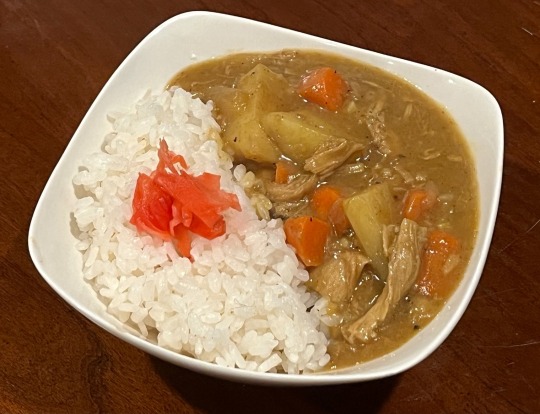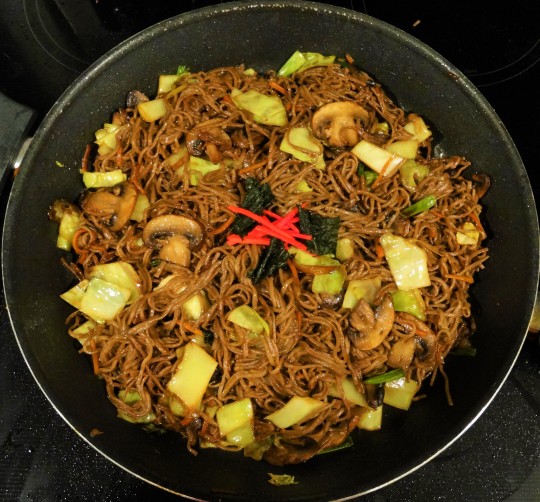#osata sosu
Text

[ID: A bowl with short-grained rice to the left and a curry to the right; a spoonful of pickled ginger tops the rice. End ID]
カレーライス / Kare raisu (Japanese "curry rice" with carrot and potato)
Kare raisu is a classic example of 洋食 (yoshoku)—Western-style food adapted to a Japanese palette. It first became popular among the Japanese navy, having been inspired by the diet of the British navy in the late Meiji period—the British themselves had appropriated and adapted dishes which they termed “curries” during their imperial rule of India.
The base of kare raisu's flavor profile is カレー粉 (kare ko, curry powder), which is used to spice the roux that thickens the curry. Since they were first manufactured and sold in the 1950s, premade curry roux cubes have been popular among home cooks as a quick way to season this dish. This recipe begins by making enough roux for the dish, for those without Japanese curry roux cubes at home.
Kare raisu is often made with chicken or pork belly, but meat is sometimes omitted. This recipe calls for sườn non chay, but if you don’t want to use a meat replacement, just increase the amount of carrot and potato!
Recipe under the cut.
Patreon | Tip jar
This recipe calls for you to make a roux as its base, as this is the most widely-used technique for this dish. A similar effect could be achieved by adding Japanese curry powder in after the onions are browned and proceeding with the dish from there, adding butter or margarine along with the water, and thickening the curry with some flour after the vegetables are tender, if desired.
Ingredients:
For the chicken:
1 package (100g) sườn non chay, or 350g other vegetarian meat substitute
(If using sườn non chay) several cups vegetarian ‘chicken’ or ‘beef’ stock from concentrate, vegetable stock, or water
1/4 tsp Japanese curry powder
A few cracks of black pepper
For the dish:
2 Yukon gold potatoes (400g), peeled
2-3 medium carrots (200g)
1 package (100g) suon non chay, or 350g other vegetarian chicken substitute
6 cups water, or enough to cover
2 tsp vegetarian ‘chicken’ or ‘beef’ stock concentrate (optional)
3 Tbsp neutral oil, to fry
2 large yellow onions, sliced
1/2 sweet apple, grated (optional)
3 Tbsp usata sosu (Japanese Worcestershire-style sauce)
1 Tbsp vegetarian oyster sauce (or substitute soy sauce)
1/4 cup coconut milk (optional)
4 cloves garlic, minced
1-inch chunk (10g) ginger, minced
Sườn non chay may be found in bags online or at your local Asian grocery–the bags will be labelled “sườn non chay” as well as “vegan meat slice,” “textured soy bean protein,” “vegetarian food,” or “vegan food.”
Apple is a fairly common but non-essential addition to this curry; it adds a subtle sweetness to the final dish without being immediately recognizable as apple. Other common additions which have the same effect are honey, jam, and mashed banana.
The Japanese Worcestershire sauce adds umami, salt, sweetness, and a hint of fruit: it may be replaced with equal parts soy sauce, ketchup, molasses, and date syrup or apple sauce.
The coconut milk adds savor and a creamy texture; the flavor of coconut is not detectable in the final dish. You could also use soy or oat milk for this purpose.
For the roux:
3 Tbsp Japanese curry powder
1/4 cup non-dairy margarine
6 Tbsp (45g) AP flour
Instructions:
For the roux:
1. Melt margarine in a small pot on medium, then reduce heat to medium-low. Add flour and toast for 15-25 minutes, stirring occasionally, until flour is lightly golden brown.
2. Add curry powder and toast for 30 seconds, until fragrant. Remove from heat.
For the dish:
1. If using sườn non chay: In a stockpot, soak sườn non chay in enough stock to cover for about an hour, until rehydrated. I also added a few cracks of black pepper and about 1/4 tsp of Japanese curry powder to the stock.
Adding a small plate to keep the sườn non chay beneath the surface of the liquid can help them to soak faster.
2. Tear sườn non chay into thin strips and return to the pot. Simmer, stirring occasionally, until the liquid has evaporated; set aside.
Soaking in broth or stock helps the flavor of the sườn non chay to be more concentrated. If you're short on time, just soak them in water until softened, squeeze the excess water out, tear them into strips, and set aside until ready to fry.
3. Prepare your vegetables. Peel potatoes and cut into wedges (if your potatoes are particularly large, halve them widthwise first). Peel the carrots and chop them with diagonal cuts, rotating the carrot about 1/4 turn between each cut (this style of cutting—rangiri—is commonly used when preparing cylindrical vegetables for simmering in stews, because it increases their surface area). Halve the onions through the root and then cut them into slices; mince the garlic and ginger.
Some cooks will cut the onions into wedges and fry them until translucent, while others cut them into thin slices and fry until they are deeply golden brown; I took the latter route to add savor to the final dish, but consult your own preferences (and time!).
4. Heat 3 Tbsp neutral oil in a large stockpot (the one you simmered the sườn non chay in, wiped clean, is fine). Fry sườn non chay until lightly browned and set aside. (If using a different meat replacement, follow the package directions for stovetop frying.)
5. In the same pot, fry onion on medium-low for 20-30 minutes until golden brown, agitating occasionally. Add ginger and about half the garlic and fry for 30 seconds until fragrant. I like to add about 1/4 of the roux at this point and fry until fragrant to increase the presence of the spice in the final dish, but this isn't common in Japanese preparations.
6. Add carrots and potato and allow to fry for about 2 minutes. Add apple and stir to combine.
7. Whisk water together with stock concentrate, Worcestershire sauce, and oyster sauce, and add to the pot. Return your meat replacement to the pot.
8. Simmer, covered, for about 15 minutes, until carrots and potatoes are fork-tender.
9. Dissolve the rest of the curry roux into the sauce and add the remainder of the garlic (this divided addition allows for a sharper garlic taste). Add coconut milk, if desired. Simmer, uncovered, until thickened, about 5 minutes. Taste and adjust sauces.
Serve warm with short-grained rice and fukujinzuke or rakkyozuke.
#Japanese#recipe#vegan recipes#vegan cooking#vegetarian recipes#yoshoku#carrots#potatoes#suon non chay#sườn non chay#apple#coconut milk#osata sosu#kare ko
107 notes
·
View notes
Photo

[ID: A large pan full of noodles, cabbage, and mushrooms, garnished with pickled ginger and nori. End ID]
焼きそば / Yakisoba
Yakisoba (”grilled noodles”) is a Japanese dish made with fried noodles and bite-sized pieces of cabbage, carrots, and sometimes beef. The most popular flavor profile for yakisoba is based on usata sosu, Japanese Worcestershire-style sauce.
Despite the name, yakisoba is not typically prepared with soba, or buckwheat, noodles; ramen-style wheat flour noodles (中華麺 / Chuka soba: “Chinese noodles”) are used.
Recipe under the cut!
Patreon | Tip jar
INGREDIENTS:
For the dish:
~ 8oz 中華麺 (Chuka soba; Chinese-style yellow wheat noodles)
1 small white onion
1 carrot
4-5 green onions
4 cabbage leaves
4-5 shiitake mushrooms (optional)
~ 1/4 cup bean sprouts (optional)
aonori and benishoga, for garnish
For the sauce:
1/2 cup homemade osata sosu, or pre-made yakisoba sauce, such as Otajoy
OR combine:
2 Tbsp brown sugar
4 tsp soy sauce
4 tsp mild vinegar (apple cider, red wine, or balsamic)
4 tsp total smooth unflavoured apple sauce, date honey, and/or raisin juice
4 tsp ketchup or tomato paste
Pinch of onion powder
Pinch of garlic powder, or 1 small garlic clove, grated
Pinch of ground coriander
Pinch of ground cumin
Pinch of ground nutmeg
Large pinch of ground cloves
Salt and ground black pepper, to taste
INSTRUCTIONS:
for the sauce:
1. mix all ingredients in a small bowl or jar. adjust to taste. the sauce should be tangy, well-spiced, sweet, and a bit fruity.
for the dish:
1. if using dried noodles, boil according to package directions. drain and place in a cold water bath to halt cooking. return noodles to the colander and lift and drop them repeatedly with your fingers in order to remove excess water. toss with a few teaspoons of a neutral oil (such as vegetable or canola) to avoid sticking and set aside.
2. prepare your vegetables. cut the onion into rings by first cutting off the stem end, then cutting the onion in half lengthwise (through the root): place it on your cutting surface cut-side down and make parallel cuts lengthwise through the onion down towards the surface (angle your cuts slightly inwards, towards the centre of the onion) about half a centimetre apart. cut off the root end to allow the rings to separate.
3. julienne the carrot by first peeling it, then cutting it widthwise into 2-inch chunks. cut each chunk into slices lengthwise, then turn the slices flat and cut each slice lengthwise again to achieve thin strips. this will be easier if you cut off a slice of each chunk lengthwise to give yourself a flat surface to lay the carrot on.
4. slice the mushrooms lengthwise and cut the green onion into 2-inch chunks. chop the cabbage leaves to produce bite-size pieces or small strips.

5. heat 3tbsp neutral oil in a large pan on high. fry noodles in oil until a few shades darker and slightly crispy. set aside.
6. in the same pan, heat another 2 Tbsp neutral oil on high. fry the onions for about 30 seconds, or until transparent and beginning to brown. add carrot, cabbage, and mushroom and fry, stirring often, for a few minutes until beginning to soften. add green onion and stir.
7. add noodles and stir to combine. you may need to add more oil at this point if the noddles are sticking.
8. add yakisoba sauce and continue to fry, tossing often, until the sauce is well-incorporated and begins to thicken and caramelise.
9. garnish and serve warm
143 notes
·
View notes